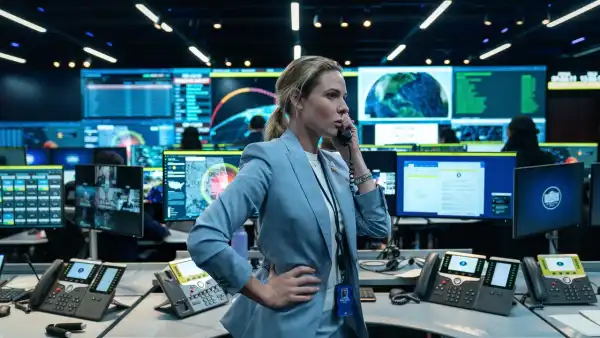
Save this storySave this storySave this storySave this story
A genuine delight when critiquing films is observing a veteran director’s artistic blossoming, just as has occurred with Kelly Reichardt. A dedicated filmmaker possessing a steadfast perspective, she previously shunned panache and style as though they were transgressions, limiting her visual language to align with the viewpoints she showcased in each work. However, with “Showing Up,” from 2022, she exhibited, for the first time, unrestrained cinematic joy, a blatant relish in creative insight and needless beauty. Perhaps it’s no accident, considering the movie concerns two artists—one functioning modestly and exquisitely, the other functioning grandly and ostentatiously—and it grants both their ardent appreciation. Now with a fresh project, “The Mastermind,” Reichardt proceeds significantly further in numerous aspects—theatrical, visual, territorial, chronological, and moral. It stands as one of the most liberated genre rethinkings and even one of the most subtly unique disruptions of cinematic storytelling I’ve encountered recently. Furthermore, the gratuitous is its primary focus.
“The Mastermind” constitutes another narrative set in the art sphere—in a way. It unfolds in 1970, predominantly in Framingham, Massachusetts, where James Blaine Mooney (Josh O’Connor), known as J.B., represents a frustrated craftsman—a woodworker unemployed and whose inflated perception of his own talent might explain his predicament. He resides with his spouse, Terri (Alana Haim), the household’s financial support, who operates a typewriter in a workplace, along with their two peculiar sons, seemingly just on either side of age ten, Tommy (Jasper Thompson) and Carl (Sterling Thompson). One day, while the family is present at the (imaginary) Framingham Museum of Art, J.B. identifies an outlet for his dormant capabilities. Spotting a security person asleep, he unlocks a display container and pilfers a miniature figure, taking it out in a glasses container that he secretively places into Terri’s purse.
Subsequently, possessing ample downtime and pent-up drive, J.B. gathers a few companions—the shaggy-haired and easy-going Guy (Eli Gelb), the uptight and forthright Larry (Cole Doman), and the rash Ronnie (Javion Allen)—to take artworks from the gallery. Even before the criminals enter the establishment, “The Mastermind” becomes an immediate robbery classic. Reichardt’s minute examination of the scheme, unmistakably heading for failure, is simultaneously profoundly poignant and hilariously absurd. Terri fashions sizable material bags to accommodate the paintings, and J.B. displays his woodworking abilities to build a compartmentalized container to house the plunder. Larry appropriates a vehicle for the departure; Guy positions another to evade pursuers; J.B. glances behind a canvas to ascertain its hanging mechanism and, to educate his team on which pieces to seize, creates sketches of them revealing a talent being sadly misapplied. Reichardt’s intense focus on the specifics of art thievery communicates authentic fascination tempered with the somber premonition inherent in J.B.’s effort to anticipate potential setbacks.
Good fortune with that. Reichardt equally delights in the comedy of mishaps: a locked automobile door refuses to yield; a school-aged girl (Margot Anderson-Song) donning a beret materializes at the gallery during the unlawful act and recites in French from a classic play; a parking zone transforms into a mundane nightmare of obstructions and observation; in the end, the perpetrators even encounter the threat of what one might term a competing entity. As the robbery’s precise arrangements succumb to disoriented improvisation, Reichardt’s awareness of the extreme uncertainty of unified action—a concept that, in its essence, possesses political weight—exceeds considerably Paul Thomas Anderson’s concentration on a revolutionary unit’s strategies and jeopardies in “One Battle After Another.”
The film’s sequences of events are constructed upon an uncommon and original societal base. As the descendant of a respected local lineage, J.B. signifies a source of chagrin for his father, Bill (Bill Camp), and a mystery—though an adored one—to his mother, Sarah (Hope Davis). Their standing provides him noteworthy advantages, which assume surprisingly substantial functions in the story. Here, as well, Reichardt carefully crafts a framework of association and causation that generates a spectrum of outcomes—some meticulously devised, others wickedly ironic—and which I wouldn’t dare reveal.
“The Mastermind” presents so many plot twists that, when assessing it, I’m unusually cautious about revelations. It furnishes the pleasures of being taken by surprise both by significant shifts and by subtle particulars whose remarkable originality merits examination yet that audiences should be permitted to uncover spontaneously. A robbery unfolds through three phases—preparation, execution, and escape—and, within “The Mastermind,” each stage manifests strikingly distinct in disposition and approach, with results that surprise in both practical and emotional respects. The most ethical approach to convey the enchantment is to share several elements yet circumvent their location within the narrative and proceed straight to the profound concept linking them. One of Reichardt’s supreme inspirations lies in forming a structure of political friction concerning the Vietnam conflict and its representations in American society—news dispatches, demonstrations and objections, responses of antagonism, governmental clampdowns—and incorporating them into the story as unavoidable facets of everyday existence.
The greatly differing portrayals are subtly yet intensely expressive; Reichardt’s exchange of words boasts alluringly peculiar inflection (commencing with a clever soliloquy for a gifted youngster) and the performers convey it with pinpoint intonations. The era’s aesthetic design is visually striking and evocative: the family’s vibrant-green Volkswagen Beetle; J.B.’s early-hours attire comprising boxer briefs, hosiery, and a long-sleeved top; the plastic container into which the morning publication is projected onto the thoroughfare. During dinner involving J.B., Terri, and the children, Davis’s Sarah commandeers the production through a solitary action—grabbing an ear of maize, dividing it in twain, and assessing the sections’ dimensions before opting for one. Nevertheless, such quotidian delights are consistently broken up by the headlines: as J.B. and a son engage in checkers on the ground, the television blasts out narratives of collegiate protests and their repression. At one juncture, the newscaster Walter Cronkite appears on a neighbor’s screen, reporting on the escalation of hostilities into Cambodia; subsequently, sounds of conflict emanate from a television documentary that J.B. is observing. A minor demonstration takes place on the boulevards of Framingham, and a major one elsewhere. Within Reichardt’s transparent method, these broader occurrences find their manner not solely into the film’s spirit yet additionally into the composition of J.B.’s ill-fated undertaking.
Though the production brims with the prevailing political predicament of the time, J.B. himself remains scarcely opinionated and seemingly navigates existence oblivious to its more expansive disputes. He’s likely in his initial thirties, adopting prolonged hair and a ragged beard devoid of affiliation with the adolescent demographic—most likely a prewar infant maturing amidst the postwar growth, his maturity transpiring between the Korean and Vietnam Wars. Still, absent even a trace of disagreement, J.B. represents a mindset of utter defiance and demonstrates his desperation through his recklessness. An exceptional instance exists within “The Mastermind” that, in a fleeting impression, encapsulates the irreconcilable paradox at its essence. While considering the theft, J.B. glances via an aperture and observes, across the path, a dwelling closely mirroring his own, with an average-looking family external, busily engaged cheerfully. He observes all that he lacks—commencing with a destination to frequent in the morning, a pursuit to undertake throughout his day, along with the affluence and the sense of belonging that accompany it. He equally observes the lifestyle from which, by plunging into a sphere of transgression, he will remain eternally excluded. The untamed and acerbic core of “The Mastermind” constitutes J.B.’s self-imposed expulsion from the habitual pattern of suburban living—from a state of normalcy that he solely replicates. In this regard, it descends from Elaine May’s “The Heartbreak Kid.”
The unlawful act materializes as an acte gratuit—André Gide’s designation for a deed whose lack of motive denotes a declaration of liberty—and spawns the existential journey of a hunted individual in flight. Consequently, “The Mastermind” morphs into a definitive film noir, replete with the sordid aspects of secrecy and seclusion, panic-driven pursuits of sanctuaries, and endeavors to erase identification. This, too, harmonizes with the politics of the period, granted the attraction that Canada exerted for those departing conscription, along with the perils confronted by resisters who remained. (I’d fail in duty to overlook emphasizing the astute and ardent portrayals by Gaby Hoffmann and John Magaro, as J.B.’s enduring associates possessing links to that realm.) Reichardt accentuates the extremity of the undertaking through a remarkably innovative form of cinematic narration that, within a more typical production, may register as a simplistic evasion. She delicately suppresses the connective structure of motivations, validations, recognitions, and avowals. Background history proves diminutive, if informative. Relationships, even the most intensely personal ones, are perceived as constants, sealed-off voids. Occurrences of minimal significance receive identical consideration and emphasis as major ones, causing actions—commencing with the most substantial action of all, the robbery—to emerge as both arbitrary and inescapable.
In place of stereotypical persona psychology, “The Mastermind” provides cinematic immersions within the present—and Reichardt equally conceives a unique visual approach to achieve this. The production overflows with lengthy segments that owe little to theatrical sequence and instead emphasize the action’s undeniable and compelling physicality. (The radiance and clamor of Rob Mazurek’s jazz accompaniment intensifies both the apprehensive vigor and the individual profundity.) Stealing an auto—how does it register? Observe the perpetrator from inception to conclusion, forcing the latch utilizing a metallic wire, activating the engine; subsequently the camera remains fixated upon him subsequent to the deed’s completion, while he undertakes nothing beyond operating the vehicle. How to conceal canvases? J.B.’s surreptitious nocturnal expedition to store them within a hidden yet unsteady locale converts balletic misfortune à la Jacques Tati into unskilled struggles that escalate in absurdity as they unfold within unbroken duration. Reichardt’s methodology toward such instances summons not mastery or even awareness yet astonishment, as if she herself were taken aback by the characters and the actions that she displays onscreen. She can solely shake her head at J.B., yet she shakes it considerably more vehemently at the world. ♦
Sourse: newyorker.com







